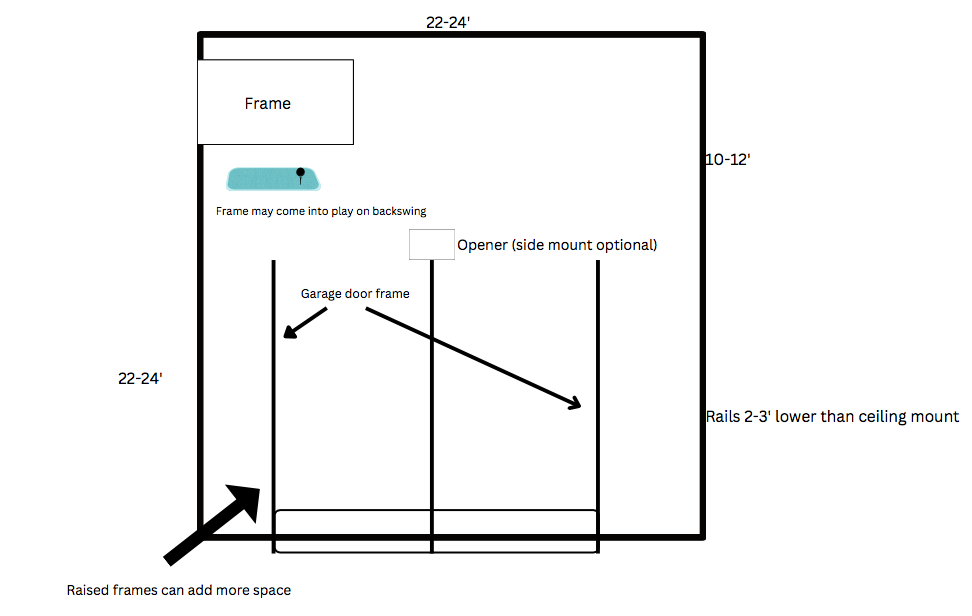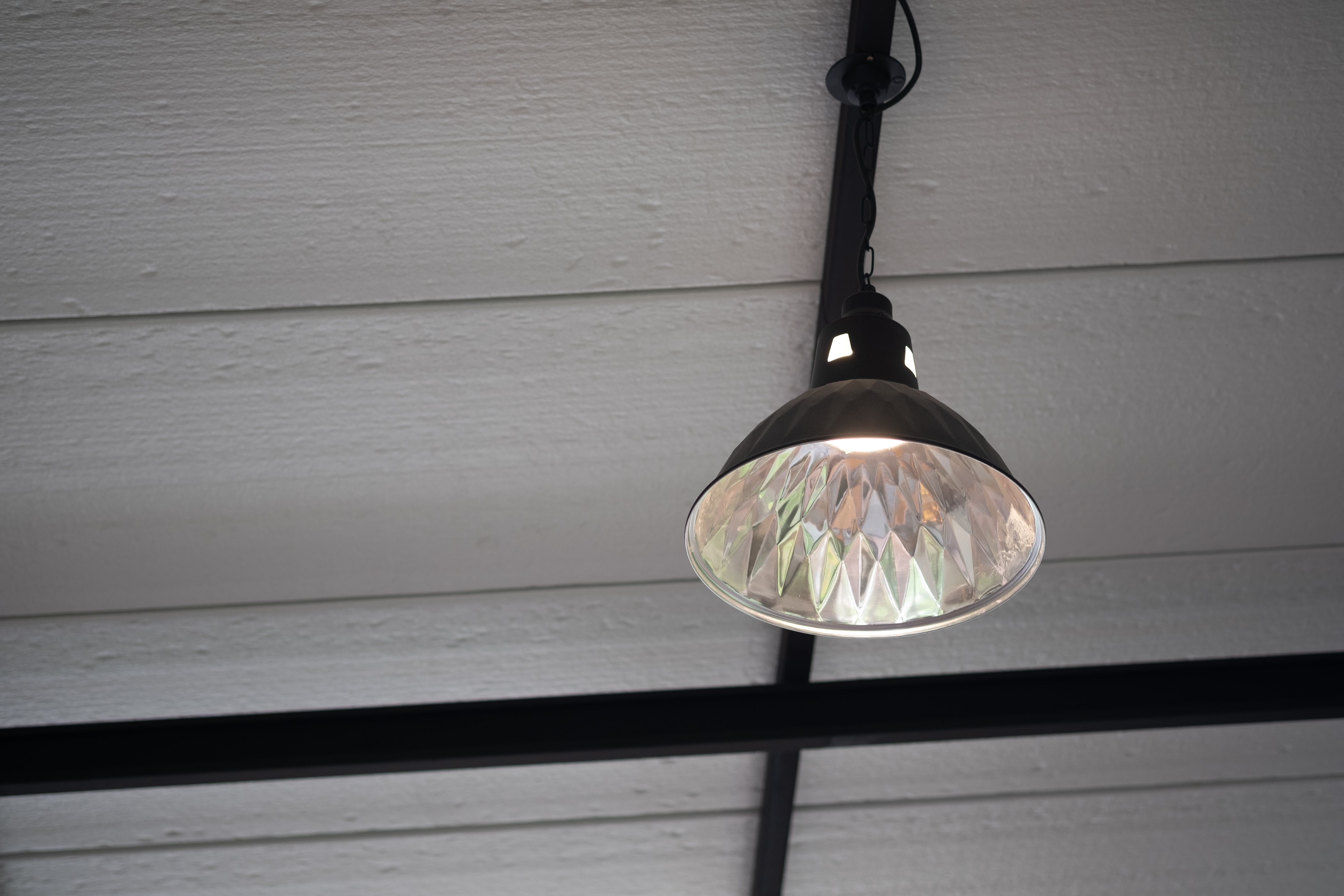
does your home Garage Big Enough for a Golf Simulator?
Many typical garages will be able to fit a golf simulator. In fact, garages are becoming common places to install golf simulators, as they already offer a lot of the dimensions and characteristics needed to build and maintain a setup. You’ll generally need around nine feet of height, ten feet of width and ten feet of length for a golf simulator, and most garages will easily be able to handle this.
Still, if you’re thinking about adding a golf simulator to your garage, it’s important to understand all of the nuances that come with this so that you can be ready for any obstacles. In this article, we’ll take a look at the pros and cons of building a garage golf simulator and offer some tips for how to design the ideal setup.
Garage Golf Simulator Pros and Cons
Before you decide on a golf simulator in your garage, be sure to take a look at the pros and cons so you have a good idea of what you’re getting into.
Pros
-
Space: As mentioned earlier, most garages will easily be able to house a golf simulator. In most cases, you’ll have enough space to allow for any number of golf simulator designs and varieties, which gives you the ability to choose exactly what you want.
-
Noise: Living room golf simulators that are in a central part of your home can be loud and keep people up at night. With a garage golf simulator, you can swing easy and know that sound will be muffled.
-
Safety: Garage golf simulators also offer a good degree of safety. You won’t have to worry about breaking any valuables or watch for pets running around as you swing.
Cons
-
Temperature Control: Garages have limited protection from the outside world. If you live in a cold climate, you may want to consider investing in added extra insulation to keep you warm during the winter months.
-
Cleanliness: Clutter and grime can easily build up in a garage. If you’re looking to design a golf simulator in this area, you may want to clean the area and keep it that way to prolong the life of your new setup.
-
Lighting: Lighting, along with other things like wifi, can be tricky in a garage. You may need to add electrical elements to help you build your setup.
How to Design a Golf Simulator For Your Garage
Once you’ve decided on your garage as your golf simulator location, it can still be stressful to take a look at the road in front of you. There are a lot of decisions to make and many considerations to take into account. We broke down the main actions to focus on to make your design go as smoothly as possible.
1. Take Measurements

Even if you think your garage is big enough for a golf simulator, it’s still important to take exact measurements to be sure. Grab a tape measure and a notepad and measure each dimension of your garage to figure out exactly what you’re working with.
2. Make Note of Any Issues and Obstacles
When it comes to garage golf simulators, there’s a lot to keep in mind. Here are some of the most common issues and obstacles that come into play when designing a setup for your garage.
Garage Door
Inspect your garage door, see what material it’s made from and look at how it operates. Doors that shut tightly and are made with extra insulation will work the best for garage golf simulators, as they’ll keep extreme temperatures out. If you have a rolling garage door with thin protection, you may want to start looking at heating options.

The design of your garage door will also come into play when it comes to dimensions. You can make tweaks to give yourself more space for a golf simulator setup. Garage door frames, for instance, can be raised to create more height. You could also add a side door opener instead of an overhead open to free up space.
Heating

You’ll have many different options to heat your garage come wintertime. Wall-mounted heaters and portable heaters are an easy and effective way to warm up your garage for a golf simulator session. If you’re building a new garage, you could even consider installing underfloor heating, which is a more expensive but very convenient option.
Insulation
Heating can also come in other forms, such as insulation. If you’re noticing that your garage tends to lose heat quickly when the cold weather comes, spend some time identifying the weak spots of your garage to see where the drafts are coming from. For lovers of DIY, you could then start adding insulation to your walls and garage door. For added protection, you could even consider investing in a new insulated garage door to keep the space warm.
Internet
You’ll also need strong internet in your garage to keep your software running properly. Consider adding an ethernet cord in your garage to stabilize that connection.
Humidity
Garages can be prone to moisture and humidity, which can then lead to mold growth. This could be detrimental to a golf simulator, so be sure to invest in dehumidifiers to keep things dry.
Lighting

Garages are also typically dim places, lacking windows and ambient light. You may need to add lamps or spotlights to illuminate your playing area so that you can see the ball clearly as you swing.
Extra Sockets
As you can see from the items here, there are going to be a lot of electrical appliances involved with your garage golf simulator setup. You may want to consult with an electrician as you plan and see what’s recommended to support your setup.
Flooring

Many people choose to add a layer of padding to their garage floor to counter the cold, hard floor of a garage. Padded floor tiles will counter the golf ball from bouncing hard off the concrete. Some people even add artificial turf to give their setup a lifelike feel.
Security
Lastly, you’ll want to consider the security of your garage. Most garages are not built like the rest of the home — meaning, they’re not as great at storing valuables and keeping intruders out. Think about adding cameras or a security system to protect your golf simulator investment.
3. Identify Your Design
Once you’ve identified any obstacles or issues with your garage simulator, it’s time to find a design that fits your specific situation. You can find a packaged option that comes with everything you need and simply put it all together when it arrives at your door. Or, you could collaborate with a trusted seller to find a setup that fits your specific needs.

At Spectrum Golf, we’re happy to work with you and design a golf simulator that is tailored to what you’re looking for.
4. Gather Your Materials
Order your products and make sure you have everything you need to complete the setup. Here are the core components to shop for:
For garages, take extra care to look at the enclosure and frame of your golf simulator, as these could add extra height to your final setup. At Spectrum Golf, we offer a 14-inch deep screen frame, which is very popular for garage golf simulator setups. You could also consider retractable golf screens that sit in front of your garage door and are easy to take down.
5. Build
Unless you’re doing a DIY build where you have to cut your pieces to the right lengths, building your golf simulator should be fairly straightforward. You’ll need to connect your pipes to build your frame, and then attach your golf screen via the supplied method — usually by grommets, straps or velcro. Then you can place your hitting mat and add extra netting if needed.

The most challenging part will likely be the projector, which will need to be mounted from the ceiling in the correct location to cast the best possible picture for your simulator.
If you need any help with the process, don’t hesitate to reach out to golf simulator experts; they should be able to guide you through the build.
FAQs
Here are some frequently asked questions about garage golf simulators.
How Much Is a Golf Simulator For My Garage?
A garage golf simulator can cost anywhere from a couple of thousand dollars to well over $15,000 and beyond. If you’re looking for the most affordable option, you’ll likely be able to construct a quality DIY golf simulator for somewhere between $2,000 and $5,000.
For those looking for something a bit extra, the sky is the limit — you can add innovative software, impressive projectors and top-of-the-line golf screens for an impressive and worthwhile investment.
Ultimately, the cost of your garage golf simulator will come down to what you’re seeking for your setup.
What Size Garage Do You Need for a Golf Simulator?
Most garages will need to be at least 9’Hx10’Wx10’L to house a golf simulator. You may need more than this for the exact simulator you want, so be sure to take measurements before you begin shopping.
Find Your Ideal Garage Golf Simulator at Spectrum Golf
Most garages will be able to fit a golf simulator, and finding the dimensions and knowing whether you have the room to build one is the easy part. It’s much more challenging to find a trusted, reliable golf simulator company to provide you with the quality parts you need at a reasonable price.
At Spectrum Golf, we’re dedicated to providing our customers with the very best when it comes to golf simulators. We offer everything you need, from fully packaged setups with everything included to individual golf mats and projectors.
For those looking for help with design, we can help out there, too. We can even collaborate with you to figure out the best options for you and tailor products to fit your unique setup. Feel free to shop online for products today or reach out to our expert team to find what you’re looking for. Contact us today!


